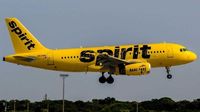Spirit Airlines, the well-known ultra-low-cost carrier famous for its bright yellow planes and no-frills approach, has taken the dramatic step of filing for Chapter 11 bankruptcy protection for the second time in less than a year. The announcement was made on August 29, 2025, just months after the airline emerged from a previous round of bankruptcy in March. This move, widely reported by outlets including Business Insider and Reuters, underscores the deep financial turbulence buffeting the U.S. airline industry—especially among budget carriers struggling to find their footing in a post-pandemic market.
In a statement to Business Insider and on the company’s press release, Spirit’s president and CEO Dave Davis acknowledged the gravity of the situation. “Since emerging from our previous restructuring, which was targeted exclusively on reducing Spirit’s funded debt and raising equity capital, it has become clear that there is much more work to be done and many more tools are available to best position Spirit for the future,” Davis said. The airline’s board, after evaluating its options and considering recent events and ongoing industry pressures, determined that a court-supervised process was the best path forward. Davis’s message: this bankruptcy isn’t about giving up, but about giving Spirit a fighting chance to survive and maybe even thrive.
So, what does this mean for travelers, employees, and the broader industry? According to Business Insider and Reuters, Spirit is maintaining its operations during the bankruptcy process. Passengers can still book flights, use credits, and cash in loyalty points as usual. Employees and contractors will continue to receive their paychecks, and the airline insists that flights and schedules will proceed uninterrupted for the time being. In an open letter to guests, Spirit described the move as “a proactive step to build a stronger foundation and future for our company.”
The airline’s current predicament didn’t come out of the blue. Spirit’s financial woes have been mounting for years, exacerbated by the COVID-19 pandemic, which hammered travel demand and piled on debt. By the time of its first Chapter 11 filing in November 2024, Spirit had lost more than $2.5 billion since the start of 2020. The company now carries $2.4 billion in long-term debt, most of it due in 2030, and reported a negative free cash flow of $1 billion at the end of the second quarter of 2025. In early August, Spirit warned investors that it might not survive the year, despite having just wrapped up its earlier bankruptcy proceedings in March. The market responded harshly: shares of Spirit Aviation Holdings, the airline’s parent company, plummeted more than 45% in after-hours trading on the day of the announcement.
Spirit’s most recent financials paint a stark picture. The airline’s total operating expenses for the latest quarter were approximately $1.2 billion—an eye-watering 118% of its quarterly revenue. The result? A net loss of around $246 million, according to Business Insider. This unsustainable cost-to-revenue ratio highlights the urgent need for deep restructuring. Industry experts have pointed out that Spirit’s previous bankruptcy focused mainly on reducing debt and raising capital, but failed to address the airline’s “bloated cost structure,” which remains a significant barrier to profitability.
To tackle these challenges, Spirit is rolling out a series of drastic measures. The airline plans to focus its flying on key markets, shrink the size of its fleet, and make sweeping changes to its cost structure, including “pursuing further efficiencies across the business.” Spirit has already announced plans to cut its presence in certain markets and reduce its fleet size, which should lower debt and lease obligations. These moves are expected to generate hundreds of millions of dollars in annual operating savings, giving Spirit a shot at regaining financial stability. The company is also in talks to sell off certain aircraft and real estate to raise much-needed cash.
But the road ahead is far from smooth. Spirit is currently embroiled in a dispute with aircraft lessor AerCap Holdings over the delivery of 36 Airbus planes scheduled for 2027 and 2028. Navigating these obligations while trying to streamline operations only adds to the airline’s headaches. Meanwhile, Spirit’s flight attendants have been warned by union leaders to “prepare for all possible scenarios.” In a letter to members dated August 29, the Association of Flight Attendants wrote, “We are being direct because even as we have many ways to fight because of our union, we also want to get you the truth about the situation at our airline and how each of us can take actions to protect and prepare ourselves for any challenge.”
Spirit’s troubles have not gone unnoticed by its rivals. Competitors such as Frontier Airlines, Southwest Airlines, and United Airlines are already moving to capitalize on Spirit’s difficulties. Frontier, in particular, has been expanding its route network, potentially positioning itself to capture market share as Spirit retrenches. Analysts suggest that other carriers may also be eyeing Spirit’s assets—especially its relatively young fleet—as the bankruptcy process unfolds. Previous buyout attempts by JetBlue and Frontier fell through before and during Spirit’s first bankruptcy, but the current situation could reignite acquisition interest.
Adding to the complexity, Spirit has been experimenting with its business model, trying to tap into a more upscale market segment with new tiered pricing and additional perks. However, these efforts have been complicated by poor demand for domestic leisure travel and “adverse market conditions” that have persisted since its last restructuring. The airline’s cost-cutting push has also led to planned furloughs—about 270 pilots and downgrades for some 140 captains to first officers, effective later this year—reflecting expected lower flight volumes in 2026. These moves come on top of earlier job cuts and furloughs.
Despite the daunting challenges, Spirit’s leadership remains publicly optimistic. The company insists that the bankruptcy filing is a “crucial step” in executing further restructuring efforts and enhancing long-term prospects. Spirit is working closely with its secured noteholders and exploring potential financing options as the restructuring process continues. The airline is committed to maintaining operational commitments, including the payment of wages, benefits, and obligations to vendors and suppliers.
For now, Spirit Airlines continues to fly, sell tickets, and serve customers as usual. But its future hangs in the balance, dependent on its ability to execute a tough restructuring plan, cut costs, and adapt to a fiercely competitive industry. Whether Spirit can emerge from bankruptcy as a stronger, more financially stable carrier remains to be seen—but for now, the airline is betting that bold action and a willingness to change course are its best hopes for survival.





